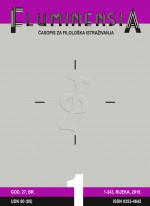FORMATION OF VERBAL NEOLOGISMS AND INTEGRATION INTO THE LANGUAGE SYSTEM
Keywords:
verbal neologisms, aspect, biaspectuality, valency, morpho-syntactic features of verbal complementsAbstract
Dynamicity in language is partly the result of the need for mutual understanding between the interlocutors, which means that it has a pragmatic nature, while on the other hand it is driven by the need to be more innovative, wittier and more creative in speech. Both processes are reflected in the emergence of new words – neologisms – only a small part of which are verbs. The present paper aims to determine, on the example of fifty verbal neologisms which have emerged in the last twenty years, whether they fit into the grammatical categories which are traditionally related to verbs. From the viewpoint of word formation, the paper examines if the new verbs are derived from native or foreign bases, which processes and morphemes are productive and to what extent the word-formational characteristics of Croatian neologisms match the existing descriptions of word formation in Croatian.
Furthermore, special attention is paid to the category of aspect. It has been noticed that among the identified verbal neologisms there is a large number of biaspectual ones (asemblirati, bekapirati, dajdžestirati), while the aspectual doublets of the perfective verbs, if they do exist, are very rare and stylistically marked (dramiti – izdramiti, lajkati – odlajkati, eskortirati – *odeskortirati). The increase in the number of biaspectual verbs is linked to their foreign origin, i.e. to only partial integration into the linguistic system of Croatian. This also has an effect on the heterogeneity of the aspectual meanings of the verb, which are a direct result of the inability to add prefixes and suffixes to these new verbs. The paper also focuses on the valence of verbal neologisms with a special emphasis on their number and the morphosyntactic features of their complements. It has been observed that the newly-formed verbs display an undeveloped valence, which affects the sentential models in which only a small number of complements and adjuncts are realized. The need for a re-examination of the existing models of grammatical description has arisen as the result of the appearance of new reflexive verbs which are impossible to describe by resorting to traditional methodology (čekirati se, overdozirati se, logirati se). The description of the grammatical features of verbal neologisms in this paper also includes the extralinguistic factors, i.e. the communication spaces that the majority of the examples of newly identified verbs come from. The domain of the new media shapes different rules for communicating information, which affects both the form and the grammatical features of verbs, and the syntactic makeup of the sentences they are used in.

